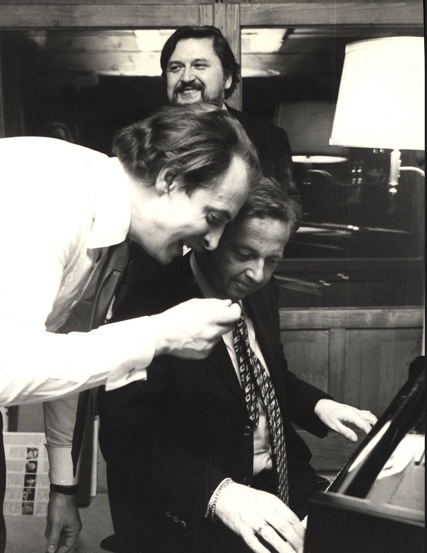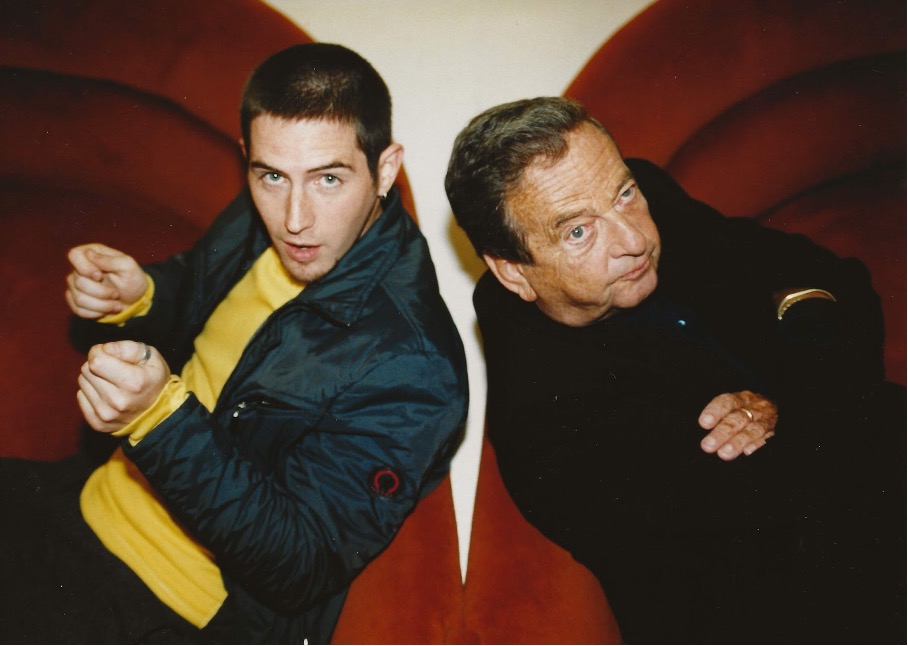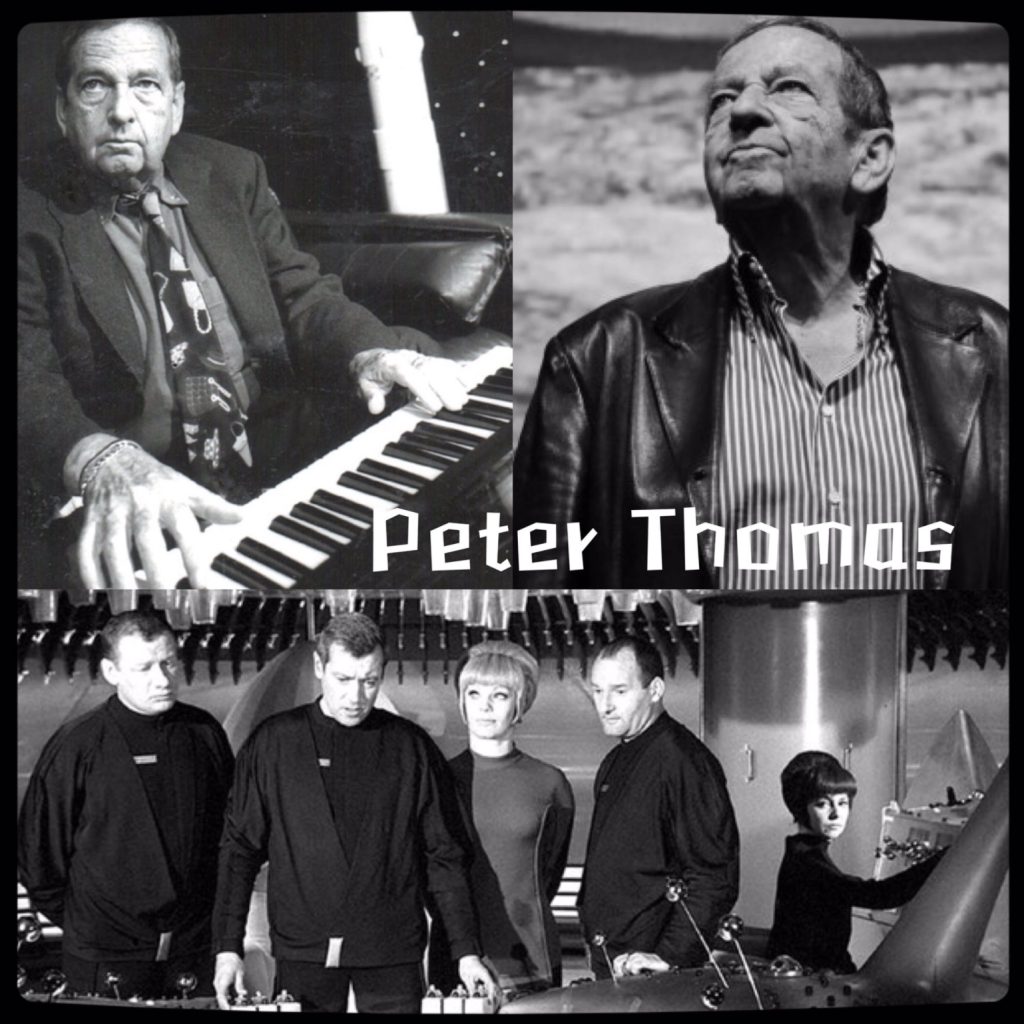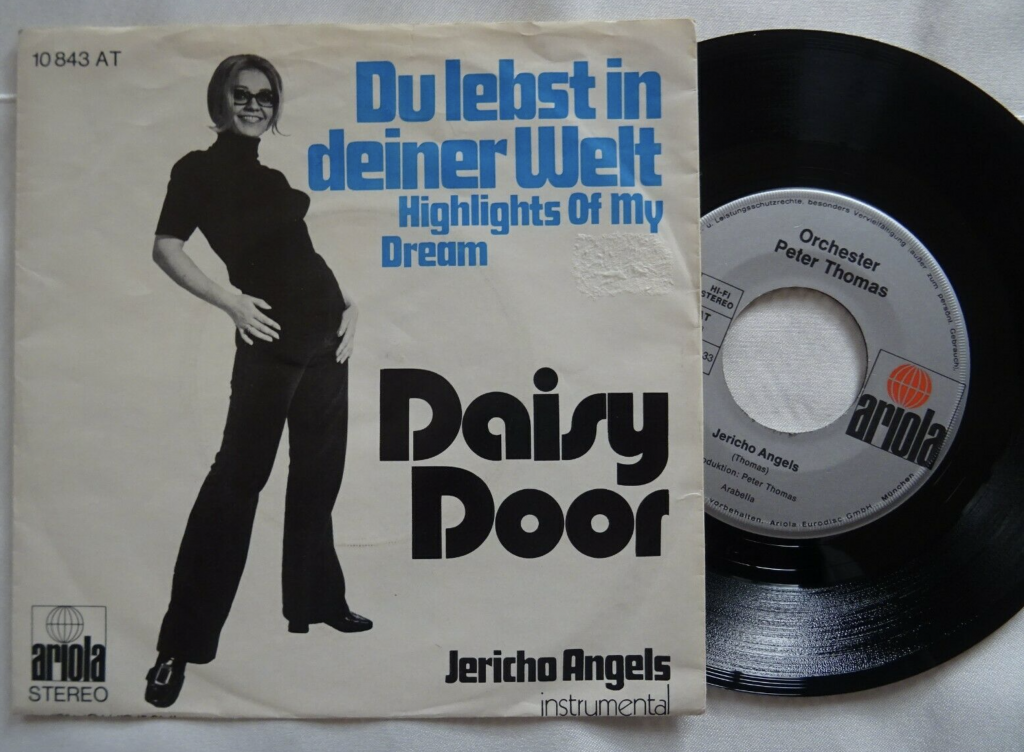Newsletter
STAY UP TO DATE
Sign up for the newsletter
We’ll keep you up to date on exciting new projects and upcoming events from Peter Thomas Music.
Fog billows over the Thames and a hunchbacked murderer trudges through Soho. Hello, this is Edgar Wallace, and welcome – not to London, but to German Wirtschaftswunder cinema. The Wallace films, with their bland mixture of ghost train horror and detective story. The most original contribution to the Wallace phenomenon was probably by Peter Thomas. His compositions for 18 Wallace films have aged the least.

“Do what you want, but don’t make it expensive” was the instruction given by film producer Horst Wendlandt to his composer. Thomas has always fulfilled both: He is on budget and he has remained idiosyncratic. For the film “The Sorcerer” he mixed women’s screams, gunshots, men’s rattles, chanting and big band with a lot of swing to create perhaps the craziest music in film history – crazy and even more insane than Kinski’s infamous outbursts on the set.

Peter also worked with young musicians. The recordings with “Ich-Zwerg” are a good example of how he was always up for new sounds. This single was released in 1999 and featured the rapper Andres Bingel with the track “Tach Herr Doktor” written by Peter Thomas.
In this clip you can discover Peter Thomas in different sequences:
– At the very beginning Peter plays the trumpet,
– in the middle (at 1’30),
– and from 1’50 on Peter plays different instruments,
– and appears at the end of the clip.

Melissa is a German television three-parter from 1966. It belongs to the series of Durbridge films that became street sweepers in Germany in the 1960s.
The music track Melissa is a music-historical classic by Peter Thomas. The song reached number 4 in the German hit parade on February 12th in 1966, where it stayed for 12 weeks. Peter Thomas recorded the track with the “Harald Banter Media Band”, with the well-known trumpeter Charly Tabor playing the bass guitar only once on this recording. The theme was only used as background music in the three-parter and was heard there on an Odeom single. In fact, the single was released in a re-recording by CBS, where Thomas then used Franz Löffler on bass guitar. The actual title and closing theme was later released under the title “Die Schlüssel” on the CD Strassenfeger, Colosseum/Cinesoundz CST 80772, together with the Melissa theme.
Peter Thomas is the composer of the well-known fanfare of the german production company Constantin-Film. Whenever the logo of “Constantin-Film” was shown, the theme music composed by him was also played.
Hier ist ein Märchen von übermorgen. Es gibt keine Nationalstaaten mehr, es gibt nur noch die Menschheit und ihre Kolonien im Weltraum. Menschen siedeln auf fernen Sternen. Der Meeresboden wird als Lebensraum erschlossen. Mit heute noch unvorstellbaren Geschwindigkeiten eilen Raumschiffe durch unser Milchstraßensystem. Eines dieser Raumschiffe ist die Orion. Winziger Teil eines gigantischen Sicherheitssystems, das die Erde vor Bedrohungen aus dem All schützt. Begleiten wir die Orion und ihre Besatzung auf ihrem Patrouillendienst am Rande der Unendlichkeit und entdecken wir in den nächsten Wochen einen ganz wichtigen und entscheidenden Eckpfeiler in der Karriere von Peter Thomas: Seine Musik für die erfolgreiche TV-Serie “Raumpatrouille Orion”.
Wir geben Ihnen einen Einblick in die musikalische Welt von Orion, werfen einen Blick hinter die Kulissen der TV-Produktion, stellen Ihnen die Protagonisten vor und erzählen die Geschichte auf eine neue Art und Weise.
Space Patrol Orion läuft derzeit auf Netflix – hier können Sie die Serie noch einmal sehen. Der Rechteinhaber Bavaria Film bereitet ein Reboot vor. “Orion” ist der schlichte Titel der Gemeinschaftsproduktion von Uncharted Territory und Bavaria Fiction. Die Handlung wird sich an der der Originalserie orientieren, im Vorfeld hatte das renommierte amerikanische Branchenmagazin Variety bereits über die Pläne berichtet.
Doch nun tauchen Sie mit uns ein in die unendlichen Weiten, die Commander McLane und seine Crew entdecken und bei denen sie von der großartigen Musik von Peter Thomas begleitet werden.
Peter Thomas needed only five days for the recordings. The financial resources were limited, but he was able to act freely musically. Thomas recalls, “the producers had a certain budget and said, ‘Do somethPeter Thomas had the ambition to write music “from the moon”, i.e. to compose music as it might actually be played in the future, using the existing musical and instrumental possibilities. Thus, apart from the vocoder for the countdown and the Hammond organ (apart from the electric guitar and electric bass), no electronic instruments were used. Peter Thomas did not intend to create a symphonic sound world like John Williams did for Star Wars. He also did not have the financial means for this production. He made a virtue out of (financial) necessity: in lean but refined arrangements he combined the instruments of a beat or rock band with a few characteristic orchestral instruments. As the central instrument running through the entire composition, however, he used the Hammond organ, which at the time was still – musically speaking – a “foreign body” for the general public. With its diverse sound possibilities and the floating and vibrating Leslie sound, it was perfectly suited to musically underscore eerie, dangerous or dramatic scenes. At the same time, it fit ideally into the band context.
ing with it.’ It was very important to finish on time, but otherwise I had every freedom. “The recordings were then made in Munich, at the Bavaria Tonstudio in Schornstraße. One of the best sound engineers, Hans Endrulat (who later also recorded the music for “Cabaret”), was there. The technical possibilities at that time only allowed a two-track recording (technical term: “shoestring”), so everything had to be recorded in one go. Thomas remembers: “Everything was recorded live. That way I knew immediately how it sounded, and each musician also played better. He wasn’t allowed to make a mistake. One mistake is okay, the second he gets a warning, and the third he gets fired. You play better with fear.” Often, the music was played directly to the film in progress.

“The Fantastic Adventures of the Spaceship Orion” is the first and best-known German science fiction television series. It was broadcast by ARD in seven parts every fortnight on Saturday evenings after the Tagesschau from 17 September 1966. The series, which cost an immense DM 480,000 per episode for its time, was created as a Franco-German co-production between WDR and the public broadcaster ORTF (Office de Radiodiffusion Télévision Française), where it was shown under the title “Commando Spatiale”. Although there were only seven one-hour episodes, the black-and-white series has enjoyed cult status for decades. When it was first broadcast on ARD, it achieved ratings of up to 56% and was therefore often referred to as a street sweeper. In Germany, the series was repeated more than 35 times on German television and by various regional broadcasters such as WDR, NDR Fernsehen, hr-fernsehen and the then Südwest 3 as well as the private broadcaster Sat.1.
In addition, there were special film screenings in the 1980s and 1990s, especially in arthouse cinemas, where the seven episodes were usually shown in two runs. In 2003, the 90-minute compilation Raumpatrouille Orion: Rücksturz ins Kino was even edited with newly filmed scenes in which, among others, the well-known writer Elke Heidenreich reported from the future as newsreader Helma Krap.
TRICKS
The use of everyday objects inside the spaceship, such as irons, pencil sharpeners or taps, which served as technical controls, is still exemplary for the series today, while the greatly enlarged ornamental fish of the Berlin Aquarium formed the backdrop for the Starlight Casino. The navigation computer in the shape of an elephant-shaped Fabergé egg is unforgettable. It is precisely this ingenuity that gives Space Patrol Orion its special charm to this day.
Even back then, the Orion spaceship was filmed as a model using the bluescreen process. This process was also used for the light storm scene. One might be amused by the fact that grains of rice were scattered around to simulate the storm. But the high-speed shots still look convincing today.
A marvellous example of the ingenuity of the time was the overkill of the experimental moon. This consisted of a plaster ball filled with rice, coffee, flour and sultanas, which was heated so much by a high-powered fan that the ball burst, was torn apart and the air turbulence ejected the contents from its interior. The supernova, which consisted of a wooden sphere coated with fire paste and set on fire, still looks impressive today.
An absolute highlight is, of course, the launch of the Orion. A photo of the Orion attached to a board was dipped upside down into a glass container filled with water and an effervescent tablet and filmed. The bubbling air bubbles of the tablets visually represented the launch from underwater base 104. When entering the launch base 104, the launch scene was simply played backwards, creating the backwards spinning vortex.
The whirlpool from which the Orion rises is often referred to as a bathtub river, but this is incorrect. In fact, the pictures of the whirlpool were taken at the Test Centre for Water Dynamics at the Technical University of Munich. The water ripples were created with the help of fans.
Galyxo – dancing on the seabed
The Starlight Casino, a futuristic bar through whose glass dome you can watch fish swimming by, is located on the seabed, which humans developed as a habitat in the year 3000. This is where McLane and his crew recovered from their work as space patrolmen and celebrated successful adventures. They had fun, relaxed, talked, laughed and flirted together. On rare occasions, differences of opinion were also settled there.
On the dance floor, people shook a leg to the Galyxo dance after wondrous choreographies. For the scenes in the Starlight Casino, Peter Thomas composed two pieces, “Ballet” and “Piccicato in Heaven”, which could not be more different, but have one thing in common: a futuristic strangeness. Dance and entertainment music of the future could be heard in the Starlight Casino. Peter Thomas had to provide the music for the dance scenes before filming, as the ballet had to rehearse the pieces beforehand. The unusual dance figures of the futuristic fashion dances were developed by the choreographer William Miliè.
The music pieces for Starlight Casino can therefore be regarded as the most original and futuristic pieces of the Space Patrol, all other pieces were only finalised after filming. Even the dance Galyxo was only named after the fact for “Raumpatrouille Orion”: Falling Back into the Cinema”.
Today there are more than 50 cover versions of the title song from “Raumpatrouille” alone (including Helge Schneider, The Beatsteaks, The Mocambo Astronautic Sound Orchestra and many more. Almost all musical genres are represented.
In addition, the title melody has also been sampled by DJ Spinna, Swollen Members and Too Strong.

Daisy Door found fame in 1971 with the song Du lebst in deiner Welt (Highlights of My Dream), composed and produced by Peter Thomas for an episode of German TV series Der Kommissar (The Police Inspector) entitled Als die Blumen Trauer trugen (The Day the Flowers Were Mourning). She lent her voice – uncredited – to the actress Sylvia Lukan. The day after the episode was broadcast, fans rushed to the record shops to try to get their hands on the track. It was not available on record at the time and had to be pressed by the label, Ariola, in super-fast time. Within three months, more than 500,000 records had been sold. The song earned Daisy three appearances on German music series ZDF Hit Parade between December 1971 and February 1972. None of her subsequent singles achieved comparable success. Today, Du lebst in deiner Welt is considered an example par excellence of a one-hit wonder.
Daisy Door sang another Peter Thomas composition entitled Oh, Oh, Oooh, Ei Ei Ei – wo immer es auch sei (Oh, oh, oooh, ei ei ei – wherever it may be), all about the mystery of the stolen ‘concert A’. In this original Peter Thomas track, the so-called ‘Pariser Stimmung’ (‘French pitch’) – a variation of concert A from the 1700s measuring 409Hz – is stored in a 2-metre-long glass case in a Parisian museum. When this concert pitch is stolen, the world is cruelly deprived of music – an event reflected in the Dadaist vocal chaos of the song. When it is found again, the world embraces the music it thought it had lost. When one knows the story, the lyrics make a little more sense – but as always with Peter Thomas, there is more than a hint of the bizarre.
The little elephant was Peter Thomas faithful companion. Holding in his trunk the “concert A” with 400 Hertz.
The episode Blumen für Zimmer 19 (Flowers for Room 19) of German crime series Die fünfte Kolonne (The Fifth Column) is all about the murder of a medical student. The film convinces with its atmospheric density. It is the debut of director Helmut Ashley. Ashley was originally a cinematographer and shot many crime films, including for the Jerry Cotton series. He was a neighbor of Peter Thomas in Kitzbühel. In the main roles of this episode you see Klausjürgen Wussow, who 20 years later would cause a sensation as Professor Brinkmann. Small anecdote on the side. This episode also stars Hannelore Elsner, who would seduce Professor Brinkmann more than 20 years later in the Schwarzwaldklinik.
In it, we are lucky enough to glance over the shoulder of 40-year-old Peter Thomas as he records music at a Hamburg studio during a brief surprise cameo. His editor was the young Hannelore Elsner.
It was 1960 when Peter received his first German Film Award (Flucht nach Berlin (Escape to Berlin)) and began to establish a name for himself. These early successes occurred alongside a major event in his private life: the birth of his first son, Philip. “It was me who made the music,” Peter recalled, “but it was my dear Cordy who drove my life. She said to me back then: ‘You have everything here, you know everyone. You address everyone as a friend, and they do the same to you. We should go somewhere else and start over.” In August 1961, the month the Wall was built, the Thomas family moved to Grünwald, a municipality near the Bavarian capital of Munich. The latter had become a culturally important metropolis and film location.
Cordy, Peter’s wife, on the change of location:
“At first, Peter wasn’t convinced. But once we got to Munich, he was immediately overwhelmed with offers of work.”
And Peter:
“When you turn 18, you decide whether you want to work for yourself or for somebody else. Anybody who has been there will know: if the money isn’t there on the first of the month, you need to be prepared to struggle. But this struggle liberates your mind and forces you to get creative. This also makes you more convincing as an artist. When one’s needs are completely met, the power to convince is somewhat diminished.”
His second son, Dominik, was born in 1962.
Never had Kitzbühel seen such a sensation! As whispers on every corner alluded to the arrival of Zarah Leander, the legendary Swedish singer and actress, Peter and Cordy Thomas threw a lavish party in her honour. High society travelled from far and wide for the occasion.
Cordy recalls the night:
I had prepared a champagne reception to welcome Zarah – and the idea was not met warmly. “What, champagne?!” came her horrified response. “NO! Give me a vodka right now, and a quadruple measure at that!”
After that, Zarah energetically gave orders for how she wanted to be received by the guests.
“I’ll take this green chair here,” she told me. “It goes well with my red hair.”
Since Zarah was never one to shy away from a drink, she simply called me Brandy. “And you, Brandy, please introduce me to all the guests – or rather, let them parade before me,” she said.
No sooner said than done. It happened that the first guest was her ardent admirer, Arndt Krupp von Bohlen und Halbach, heir of Germany’s Krupp steel dynasty.
Zarah found a kind word for all. When I introduced her to the handsome French ambassador, however, Zarah grinned and whispered in my ear: “Please tell this beautiful man that I find his nose very promising indeed.”
At this, I was lost for words. “My dear Zarah,” I laughed, “you’ll have to tell him the smutty stuff yourself!”
Later, after Zarah had performed countless renditions of her current hit Wodka für die Königin (Vodka for the Queen), she was overcome by a sudden tiredness and allowed her husband, Arne, to lead her to the bedroom.
The guests left behind were sorely disappointed – until Arne made a magnificent proposal. “Would you like to see my Zarah sleeping?”
The guests, of course, thought this was marvellous. The illustrious company marched single file up to the first floor.
Oh, what a vision she was in her lace nightgown, red wig set aside! The blissful silence was interrupted only by Zarah’s regular, rather ear-splitting snores. Her devoted fans could scarcely believe their eyes. The Krupp heir, Arndt, a sensitive character, was overcome with emotion at the sight of his beloved and had to turn away.
A female fan jostled her husband. “You see, Seppi,” she said, in her distinctive Bavarian dialect, “even international stars snore. It’s not just me!”
The next day, church began an hour later than usual. There was only one subject on everyone’s lips: Zarah snoring and wigless in bed!
Sachs blazed his way through the sixties and seventies as a true ‘playboy’ of the era. He scattered 1000 red roses over Brigitte Bardot’s villa from a helicopter and cruised around the St Tropez seafront in his Riva yacht, watching the glamorous lives of the jeuneusse dorée pass before him.
A look at his pictures and work, however, reveals that Sachs was not at all an exuberant bon vivant at heart, but something of a German pedant: orderly, precise and driven. As art expert Otto Letze remarked: “The more you dig into the depths of Sachs’ work, the more fascinating he becomes – as a perfectionist, a patron, a collector, a lateral thinker in the way he approached his collecting and his own creations. He is a fascinating personality; a pioneer of the first order who creates revolutionary things.”
In film, Sachs was an early adopter of time lapse and super slow motion. He played with digital technology and tried things out, often with amazing results.
Sachs’ first art film Le petit port told the story of a small port in the Swiss city of Lausanne. His search for a suitable musical collaborator led him to Peter Thomas, who was recommended by Sachs’ editor at the time. For Sachs, the collaboration was “outstanding; [Peter] is a lively chap and a fantastic musician. He composed to a tight schedule, and the finished recordings were always first-class. We never had any artistic run-ins. On the contrary, he was very adept at shifting gears.” Other films were made in quick succession – including Les giraffes de St. Tropez, in which the two (very much human) main actors take part in a 15-minute cinematic declaration of love. It is a homage by Gunter Sachs and Peter Thomas to their (then) adopted home in the south of France; to the wild-partying, St Tropez lifestyle of ‘seeing and being seen’.
The musical partnership between the two men reached its zenith with ski film Happening in White (1969), which caused a stir many years before Willi Bogner had a similar idea with Fire and Ice in 1986. Sachs’ film opens with the Swiss Glacier Express racing through the tunnels, while daring skiers soar into the sky and compete with fighter jets for elegance and strength. During their work on this documentary, Sachs was “particularly impressed by Peter: I worked with super slow motion and the accompanying film score was a roaring success. Peter is a force of nature; he never tackles the recording process with anything less than a hundred percent. ‘Give ‘em hell!’ he commands, and everything is always right the first time. He is a consummate professional.” Peter wrote music for a total of five short films, with most of the recording work being carried out in Munich. Just as the two men enjoyed a long-lasting friendship, their respective spouses, Cordy (Peter) and Mirja (Gunter) also developed an enduring and affectionate bond. For Peter Thomas, Gunter Sachs was “the archetype of a society – a way of living – that one has to search hard for today; like Aladdin with the magic lamp…”.
We’ll keep you up to date on exciting new projects and upcoming events from Peter Thomas Music.
For licencing or the MuZikBeater label related questions please visit https://muzikbeater.de
© 2021 Peter Thomas – Music